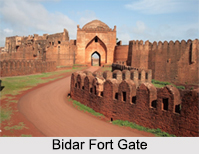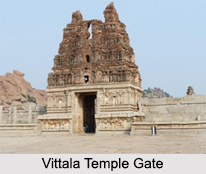 Gates of Karnataka are built by the South Indian and the Mughal kings of the early and medieval era. The early Karnataka was governed by Pallava Dynasty, Cholas and Rashtrakuta Dynasty. The art and architecture was flourished from the early times to the medieval era. The pre-history of Karnataka goes back to a Paleolithic hand-axe culture evidenced by discoveries of, among other things, hand axes and cleavers in the region. The evidence of Neolithic and megalithic cultures has also been found in the state. The gold discovered in Harappa was found to be imported from mines in Karnataka. After the downfall of Indus Valley Civilization, Karnataka came under Nanda Dynasty and later the Mauryan Empire. Following the decline of Nandas, Mauryas, and the Satvahanas, the land came under the Badami Chalukyas, Rashtrakuta Empire of Manyakheta and the Western Chalukya Dynasty. In medieval era, Karnataka came under the influence of Islamic Dynasties. From that time to the British era, Mysore became the administrative seat.
Gates of Karnataka are built by the South Indian and the Mughal kings of the early and medieval era. The early Karnataka was governed by Pallava Dynasty, Cholas and Rashtrakuta Dynasty. The art and architecture was flourished from the early times to the medieval era. The pre-history of Karnataka goes back to a Paleolithic hand-axe culture evidenced by discoveries of, among other things, hand axes and cleavers in the region. The evidence of Neolithic and megalithic cultures has also been found in the state. The gold discovered in Harappa was found to be imported from mines in Karnataka. After the downfall of Indus Valley Civilization, Karnataka came under Nanda Dynasty and later the Mauryan Empire. Following the decline of Nandas, Mauryas, and the Satvahanas, the land came under the Badami Chalukyas, Rashtrakuta Empire of Manyakheta and the Western Chalukya Dynasty. In medieval era, Karnataka came under the influence of Islamic Dynasties. From that time to the British era, Mysore became the administrative seat.
Bidar Fort Gate, Bidar
Bidar Fort gate is the entrance of the fort. This fort was established by Sultan Alla-Ud Din Bahman of the Bahmanid Dynasty. Bidar city and fort are located on the edge of the Bidar platueau, the northernmost in Karnataka. The plateau area, comprising low laterite hills, ends to the north at the Manjira River, a major tributary of the Godavari River. Bidar Fort gate was rebuilt using red laterite stone. Bidar fort was also formed in this stone. The fort was constructed on the edge of the plateau. Bidar fort has a haphazard rhombus-shaped layout.
Daria Daulat Bagh Gate, Srirangapatna
Daria Daulat Bagh Gate in Srirangapatna was built by Tipu Sultan. This is the entrance of the Daria Daulat Bagh Palace and the Gardens. Daria Daulat Bagh Gate is built in the Indo-Sarcenic style is mostly made of teakwood. Daria Daulat Bagh has a rectangular plan and is built on a raised platform. There are open corridors along the four sides of the platform with wooden pillars at the edges of the plinth.
Vittala Temple Gate, Hampi
Vittala Temple Gate of Hampi is an excellent example of Vijaynagara art and architecture. The route to the Vijaya Vittala temple is scenic, though the road to Vittala Temple is harsh. There are ruins of some mandapas along the way, and a tank. Vijayanagara architecture of 1336-1565 AD was a notable building phrase that developed during the rule of the Vijayanagar Empire. The empire ruled South India, from their regal capital at Vijayanagara, on the banks of the Tungabhadra River in modern Karnataka.



















